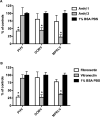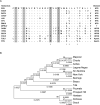Maporal virus as a surrogate for pathogenic New World hantaviruses and its inhibition by favipiravir
- PMID: 21566265
- PMCID: PMC3243073
- DOI: 10.3851/IMP1729
Maporal virus as a surrogate for pathogenic New World hantaviruses and its inhibition by favipiravir
Abstract
Background: Pathogenic hantaviruses geographically distributed in the Old World cause haemorrhagic fever with renal syndrome (HFRS), whereas New World hantaviruses are the aetiological agents of hantavirus cardiopulmonary syndrome (HCPS). Ribavirin, a drug associated with toxicities, is presently indicated for treatment of HFRS, whereas treatment of the more frequently lethal HCPS is limited to supportive care. Because of the need for safe and effective antivirals to treat severe hantaviral infections, we evaluated favipiravir (T-705) against Dobrava and Maporal viruses as representative Old World and New World hantaviruses, respectively. Dobrava virus causes HFRS in Europe. Maporal virus (MPRLV), recently isolated from western Venezuela, is phylogenetically similar to Andes virus, the principal cause of HCPS in Argentina.
Methods: Hantavirus replication in the presence of various inhibitors was measured by focus-forming unit assays and quantitative reverse transcriptase PCR. Phylogenetic relationships were assessed by the neighbour-joining and bootstrap consensus methods.
Results: Here, we show that infection of Vero E6 cells with MPRLV is dependent on β3 integrins, similar to that reported for pathogenic hantaviruses. Furthermore, by analysis of molecular determinants associated with the G1 glycoprotein cytoplasmic tail, we show the close genetic proximity of MPRLV to other HCPS-causing hantaviruses in these regions predictive of pathogenicity. We also demonstrate anti-hantavirus activity by favipiravir with inhibitory concentrations ranging from 65 to 93 μM and selectivity indices>50.
Conclusions: Our data suggest that MPRLV may serve as a safer alternative to modelling infection caused by the highly lethal Andes virus and that hantaviruses are sensitive to the effects of favipiravir in cell culture.
Figures



Similar articles
-
In vitro and in vivo activity of ribavirin against Andes virus infection.PLoS One. 2011;6(8):e23560. doi: 10.1371/journal.pone.0023560. Epub 2011 Aug 10. PLoS One. 2011. PMID: 21853152 Free PMC article.
-
T-705 (favipiravir) inhibition of arenavirus replication in cell culture.Antimicrob Agents Chemother. 2011 Feb;55(2):782-7. doi: 10.1128/AAC.01219-10. Epub 2010 Nov 29. Antimicrob Agents Chemother. 2011. PMID: 21115797 Free PMC article.
-
Low-dose ribavirin potentiates the antiviral activity of favipiravir against hemorrhagic fever viruses.Antiviral Res. 2016 Feb;126:62-8. doi: 10.1016/j.antiviral.2015.12.006. Epub 2015 Dec 19. Antiviral Res. 2016. PMID: 26711718 Free PMC article.
-
Hantaviruses: an emerging public health threat in India? A review.J Biosci. 2008 Nov;33(4):495-504. doi: 10.1007/s12038-008-0068-x. J Biosci. 2008. PMID: 19208975 Review.
-
Zoonotic Hantaviridae with Global Public Health Significance.Viruses. 2023 Aug 8;15(8):1705. doi: 10.3390/v15081705. Viruses. 2023. PMID: 37632047 Free PMC article. Review.
Cited by
-
An update on the progress of galidesivir (BCX4430), a broad-spectrum antiviral.Antiviral Res. 2021 Nov;195:105180. doi: 10.1016/j.antiviral.2021.105180. Epub 2021 Sep 20. Antiviral Res. 2021. PMID: 34551346 Free PMC article. Review.
-
Antiviral Activity of Favipiravir (T-705) against a Broad Range of Paramyxoviruses In Vitro and against Human Metapneumovirus in Hamsters.Antimicrob Agents Chemother. 2016 Jul 22;60(8):4620-9. doi: 10.1128/AAC.00709-16. Print 2016 Aug. Antimicrob Agents Chemother. 2016. PMID: 27185803 Free PMC article.
-
Ribavirin protects Syrian hamsters against lethal hantavirus pulmonary syndrome--after intranasal exposure to Andes virus.Viruses. 2013 Nov 8;5(11):2704-20. doi: 10.3390/v5112704. Viruses. 2013. PMID: 24217424 Free PMC article.
-
Favipiravir (T-705), a broad spectrum inhibitor of viral RNA polymerase.Proc Jpn Acad Ser B Phys Biol Sci. 2017;93(7):449-463. doi: 10.2183/pjab.93.027. Proc Jpn Acad Ser B Phys Biol Sci. 2017. PMID: 28769016 Free PMC article. Review.
-
Highlights in antiviral drug research: antivirals at the horizon.Med Res Rev. 2013 Nov;33(6):1215-48. doi: 10.1002/med.21256. Epub 2012 May 2. Med Res Rev. 2013. PMID: 22553111 Free PMC article. Review.
References
-
- CDC Outbreak of acute illness--southwestern United States, 1993. MMWR. Morbidity and Mortality Weekly Report. 1993;42:421–424. - PubMed
-
- Gonzalez Della Valle M, Edelstein A, Miguel S, Martinez V, Cortez J, Cacace ML, Jurgelenas G, Estani SS, Padula P. Andes virus associated with hantavirus pulmonary syndrome in northern Argentina and determination of the precise site of infection. American Journal of Tropical Medicine and Hygiene. 2002;66:713–720. - PubMed
-
- Hjelle B, Lee SW, Song W, Torrez-Martinez N, Song JW, Yanagihara R, Gavrilovskaya I, Mackow ER. Molecular linkage of hantavirus pulmonary syndrome to the white-footed mouse, Peromyscus leucopus: genetic characterization of the M genome of New York virus. Journal of Virology. 1995;69:8137–8141. - PMC - PubMed
-
- Johnson AM, Bowen MD, Ksiazek TG, Williams RJ, Bryan RT, Mills JN, Peters CJ, Nichol ST. Laguna Negra virus associated with HPS in western Paraguay and Bolivia. Virology. 1997;238:115–127. - PubMed
Publication types
MeSH terms
Substances
Grants and funding
LinkOut - more resources
Full Text Sources

